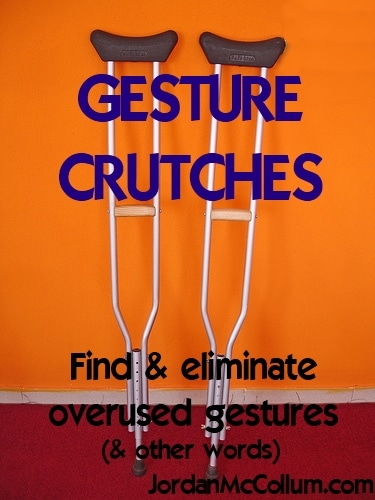I always try to edit my books to streamline and strengthen my prose. Here are my best techniques.
Set a goal
Maybe you really just want to tighten your story, so you don’t have a specific number goal. I think you should set one anyway. Hopefully you’ve learned how wordy you tend to be and how wordy your voice should be, so you can adjust your goal accordingly.
My goal was dictated by word count—I wanted the third book in the series to be close to the length of the first. That gave me 7000 words to cut over 300 pages, an average of 24 words per page (always round up; you can’t count cutting part of a word).
I wanted to give myself a cushion for smoothing rewrites and for pages that were already pretty tight, so I made my goal 30 words a page. When I move to the next page, I check the document word count and try to knock it down by 30. Sometimes I can, sometimes I can’t, sometimes I blow it away, but it gives me a specific goal to shoot for and stretch for rather than just cutting “some” words.
Highlight your weak, empty &/or echo words
I use a macro to do this, and I love it. I’ve set it up to color code “empty” words. Words that can often be cut entirely are “highlighted” in black, making them invisible. If the sentence reads just as well without it, I can cut that word. Sequencing words like before/after/while/as are in dark blue. A lot, a little, pretty, etc. are in another color. Suddenly, finally and slowly are flagged in red. The macro also turns several pronouns orange (text color) so I can make sure I’m using the strongest possible words. You might also highlight “because, “since” and “so that,” as telling flags. This doesn’t include the 60 words I track to monitor emotions, visceral reactions, body language and overused words I want to track by comparing the full sentences.
This does highlight a lot of things that I don’t need to highlight (because I haven’t gotten down the “whole words only” option yet), like “AS much AS” or “adJUSTment,” but because I’m going to be reading every page, it’s okay.
When I finish working with a page, I take out the highlighting and text color changes. Then if I scroll past it, I know it’s done.
Go page by page
Why go in random order? Sometimes it’s easy to start reading and following the story. This way, I can’t get sucked into the story and forget to edit closely. I use Random.org to randomize my page numbers.
The longer explanation of the process: I use Excel. I put “1” in A1 and fill the cells in a series to make a list of my page numbers, 1 to 300 or whatever. Then I have Random.org generate a list of random numbers, 1 to whatever (should be at least as high as your page count, but can be higher) in one column. I cut and paste that list into column B of the spreadsheet. I select both columns and sort the range by column B.
Why don’t I just use Random.org’s list? True random numbers will skip some digits and duplicate others, so some pages will be skipped. This way makes sure every page is on the list.
Of course, my page count goes down as I do this. If I cut a page off chapter 4, all the subsequent pages are shifted up, right? So sometimes, especially as I approach the last quarter of the edit, my random page has already been edited, I scroll until I can find one that still has those highlighted words from the previous step.
The actual editing
As I mentioned above, some of the first things I look at are empty, overused and commonly misused words.
Contractions
These are words that can be distilled, reduced or cut altogether without altering meaning.
- Try to/and (technically it should be try to, not try and, but try and is very common in speech)
- start to, begin to
- Reach for
- was going to >> would/will
- to be able to >> could/can
- at him, to her, for me, especially if there are only two people in the scene.
- Now, right now (can be especially awkward in past tense)
- Seems to, looks like >> well, does it?
- And, and then, but. Do these clauses belong together? Do they HAVE to be together (choppiness is a valid reason to join them).
- Of him, of it, of yours >> his X, its Y, your Z.
- The _A_ to the _B__ >> B’s A
- have to have >> need
- figure out where/what Q is >> find Q
- that
- that is/are/was/were
Progressive & paraphrastic tenses
- Along with was going to above, do we need “I was calling” or will “I called” suffice? (Not sure? Check out this discussion on progressive tenses.)
Stacked prepositions
Usually one of these is redundant.
- Out of (from?)
- Off of
- down on (write it down on, sit down on)
- over to
- Rephrasing to avoid prepositions–I gave the book to him. I gave him the book.
Evil phrases
These empty phrases don’t mean anything and just pad the word count. They can usually be cut:
- In order to >> to
- The fact that (cut)
- at this point
Null subjects
Null or dummy subjects are common in English, but they can create weak sentences:
- There was/were, It was, Those/These were
- There were four men in the room. Four men stood in/ringed the room.
Unnecessary subjects
This is very dependent on the genre and voice, but you might be able to get away with cutting unnecessary subjects, such as in dialogue. “Are you going to the party?” in real life might end up “You going?” or “Going to the party?”
Redundancy
- Nodded his head up and down
- shook his head no
- the driver in the front seat (obviously they sat in a seat)
- the smile on his face (where else do you smile?)
Semantically empty phrases
This is one of my favorite places to cut. I have a tendency to have a lot of commentary, shades of meaning, hints of backstory. That can be great, but it can also really start to weigh down the story. I try to look critically at a lot of these phrases. Can readers infer that if someone’s holding the elevator for the POV character, it’s “for me to catch up” (and cut those 5 words)? Do we need all of the info in “We weren’t planning on a Russian side trip when we packed, so our heavy winter gear is back home” or will “We didn’t pack for a Russian side trip” convey the message and the humor a lot better? (With 11 fewer words.)
One word or two
Use a dictionary you trust (I use Merriam-Webster Online) and check to see if you’ve got your words right. Is back seat one word or two? Back up? As a verb, adjective or noun?
POWER writing
This edit isn’t just to make the book shorter. I’m doing it to make the book stronger. Following Margie Lawson’s advice, I’m adding rhetorical devices and power words. I’m tweaking the cadence, moving words to more powerful positions and creating more vivid imagery. I have lists of rhetorical devices on my screen, chosen by what effect I’m going for in the scene.
Sometimes this adds words, sometimes it takes them away. To go back to my above example, I decided “side trip” was weak, and settled on “detour” instead—cutting another word and ending the paragraph on the more powerful alternative.
What do you think? What ways have you found to streamline and strengthen your writing?


 Last week, I gave a class at the LDStorymakers Conference on gesture crutches. You can find my presentation here, but today I’m sharing the resources I cited in class!
Last week, I gave a class at the LDStorymakers Conference on gesture crutches. You can find my presentation here, but today I’m sharing the resources I cited in class!
